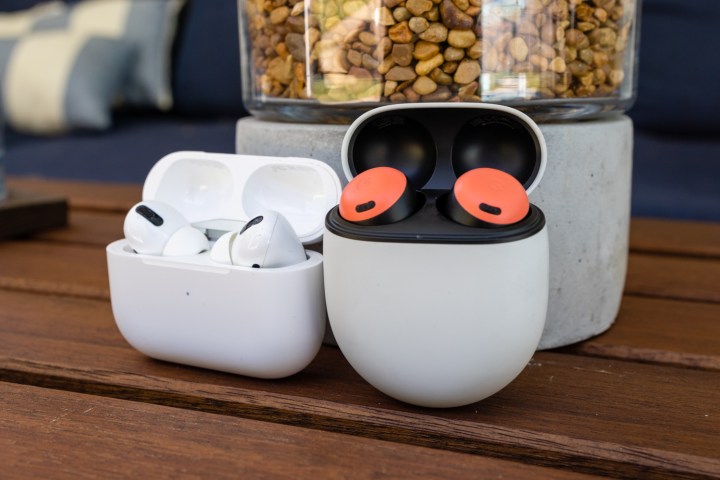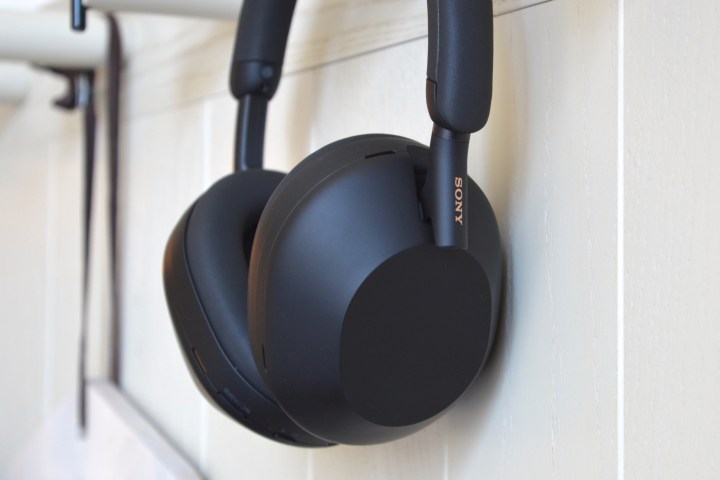Wouldn’t it be great to quickly and easily switch between audio sources with your Bluetooth headphones without manually disconnecting and pairing them to one device at a time? As with most consumer tech wonders, the dream has become a reality. In this deep dive, we’ll explore an excellent audio feature known as Bluetooth multipoint.
Introduced in 2010 with the rollout of Bluetooth 4.0, Bluetooth multipoint was a game-changer for those using Bluetooth headsets in the workplace. It allowed for a second phone line’s unanswered calls to be instantly placed on hold, and this was only the beginning of Bluetooth multipoint’s capabilities and its compatibility with various devices.
But how exactly does multipoint work outside of a call center setting? And why isn’t the feature talked about more by the brands that build it into their products? Join us, dear reader, on a journey into Bluetooth multipoint’s past, present, and future.
How does Bluetooth multipoint work?
To better understand the science behind multipoint audio, it’ll help to quickly examine how Bluetooth functions as a whole.
Traditionally, a simple wireless network (known as a piconet) is the digital thread that links a single set of Bluetooth headphones to a Bluetooth-ready source, be it a phone, tablet, computer, or game system. Within this A-to-B handshake, your headphones (Device A) call all the shots in the piconet, dictating the volume at which your phone plays music when a voice assistant is called upon, etc.
Device B in this piconet (the audio source) has only one job: to listen for and follow Device A’s commands. So far, so good? Let’s see how multipoint figures are included in this chain of command.
Normally, a Bluetooth piconet connects only two devices. But when Device A supports multipoint connectivity, you can link up with two or more Device B sources, allowing you to maintain a connection with two peripherals (phone, tablet, etc.) simultaneously, and seamlessly switch between them.
Now that we’ve addressed the basics of a multipoint setup, let’s explore the different types of multipoint audio a little further.
Simple, triple, advanced (and your Apple ID)

There are three main types of multipoint audio: simple, triple, and advanced connectivity. Simple multipoint is generally the kind of multipoint used most often by consumer tech product developers, wherein a single set of headphones can be linked to two sources at once.
Triple connectivity is less common, which, as the name implies, allows up to three audio sources to be linked to a single set of headphones or wireless earbuds. The Technics EAH-AZ80 is an excellent example of a triple multipoint.
The third type, advanced, has been around for a bit longer than simple multipoint but is very similar. Most commonly associated with call centers, advanced multipoint adds one additional feature to the piconet: the ability for the headset to answer two calls at once and to have one of them placed on hold, allowing you to easily switch between them.
There’s also another approach to multipoint used we have to talk about. Companies like Apple, Samsung, and Google for example, prefer to do things a bit differently with their own versions of automatic device switching.
If you have a pair of Apple AirPods Pro, for example, Apple’s automatic audio switching lets you seamlessly switch between devices like your iPhone, iPad, and Mac. If you’re a Samsung Galaxy Buds Pro owner, Samsung’s Galaxy Auto switching, via the Wearables app, will remember your paired devices and automatically switch between them when, say, a phone call comes in or it detects music has started on another device. Using Google’s Fast Pair and audio switch features on an Android device, a set of Google Pixel Buds Pro earbuds, for example, allow you to seamlessly switch between compatible devices as you use them.
What is multipoint good for?

The main benefit of Bluetooth multipoint is that a single set of Bluetooth headphones or earbuds can be connected to more than one device at once, allowing you to switch between two different source devices without having to manually disconnect your headphones from one device and reconnect them to another.
But how exactly does the chain of command work when determining which media takes precedence? To break things down, let’s look at the average multipoint setup.
In the following scenario, we’re going to say that you’re rocking a pair of Sony WH-1000XM5 headphones, and they’re connected to both your iPhone (which you always have on your person) and your work computer. The typical hierarchy of media is as follows: phone and video calls take priority over voice assistants and system sounds, and digital assistants, device alarms, and notifications are prioritized over the audio of content like Netflix streaming, Spotify tunes, and whatever music or podcasts you have downloaded onto your phone or computer. Now, let’s put things into action to see how this all plays out.
Imagine you’re at the office, wearing your favorite headphones, and they’re simultaneously connected to your iPhone and work computer.
You’re on a Teams video call on your computer with a colleague, and your partner sends you a text message to your phone, the notification sound of which comes through on your headphones. But work is important, so you pay no attention—then your phone rings — it’s your better half. Now you’re in trouble. You answer the call, and while the Teams video stream stays active on your computer screen, its audio is muted in your headphones as the phone call audio takes priority. Once the call is ended; it’s back to your Teams call.
Another scenario could be when you’re listening to music through a streaming service like Spotify on your computer, and audible notifications, such as calendar reminders, text messages, WhatsApp messages, and more, come through from your phone. After you silence the alarm or the notification ends, your Spotify playlist starts playing again. Alternately, if a phone call or Zoom call were to come through on your phone, the music on your computer would pause while you take the call and resume when your call ends.
In a perfect world, that’s how it should work — an easy, breezy back and forth between your devices and headphones — and in theory, it’s possible. However, several factors come into play, such as the capabilities and compatibility of your devices and how you have your computer and phone settings configured. For example, while your music may pause for a notification or a call, it might not always start up again automatically. Or when your Teams or Zoom call comes back, you may need to reactivate the microphone. All little things, but this is to say that while Bluetooth multipoint is a tech that makes for some amazingly convenient and helpful features, it’s still evolving and isn’t perfect … yet.
How to shop for Bluetooth multipoint products
When buying a Bluetooth multipoint product, there are several things to consider. First, determine your needs and usage scenarios. For example, do you want headphones for exercising, earbuds for daily commuting, a speaker for home use, or a car kit for hands-free calling while driving? Also, consider whether you want automatic switching between devices, which can be convenient for multitasking, or if manual control is sufficient for your usage.
Compatibility is also important, as not all products work with every device. Please ensure the product you choose is compatible with your smartphone, tablet, laptop, or any other device you intend to use.
Key features to look for when buying a product include an easy pairing process, excellent sound quality, and good battery life. An easy pairing process can save you time and hassle, while excellent sound quality ensures an enjoyable listening experience. Good battery life is essential for uninterrupted usage.
Build quality and manufacturer support are also important considerations. A well-built product will likely be more durable and perform better over time. Additionally, reliable manufacturer support can be crucial if you encounter any issues with the product.
Read reviews and do thorough research before making a purchase. Feedback from other users can provide valuable insights into the product’s performance and reliability. If possible, try testing the product in-store to get a better feel and determine if it meets your expectations.
Lastly, consider your budget and what trade-offs you will make for a lower price. Determine which features are the most important to you, and be prepared to make informed decisions based on your budget constraints. Considering all these factors, you can make a well-informed decision when purchasing a Bluetooth multipoint product.
Services Marketplace – Listings, Bookings & Reviews

